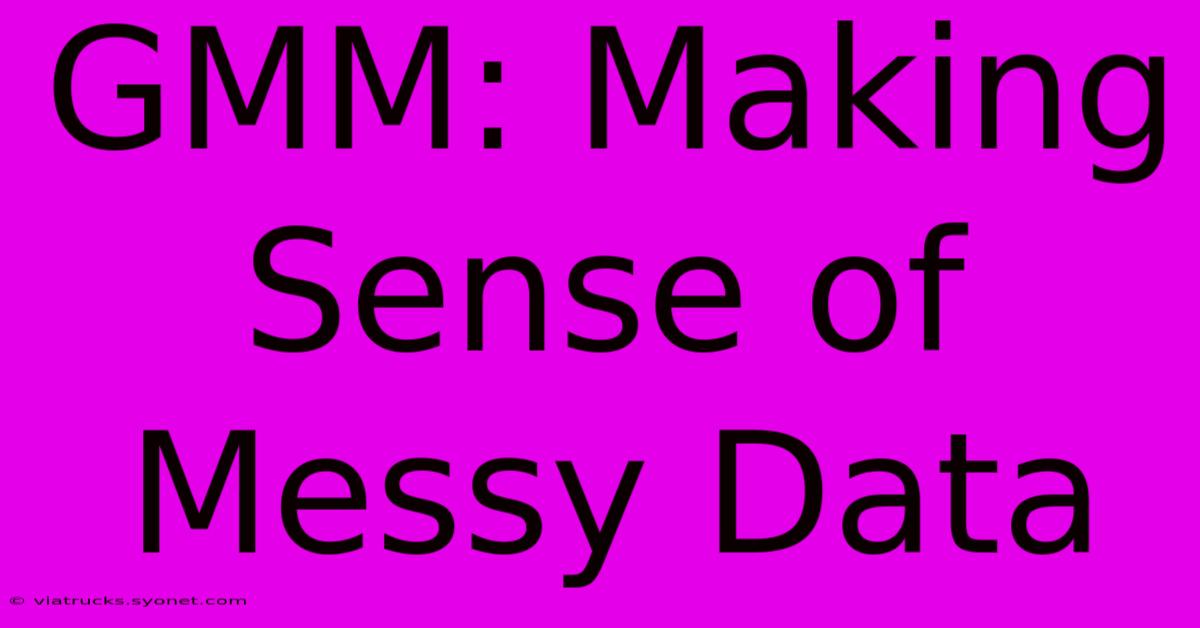GMM: Making Sense Of Messy Data

Table of Contents
GMM: Making Sense of Messy Data
In today's data-driven world, we're often faced with messy, complex datasets that defy simple analysis. Traditional methods struggle to uncover the underlying structure within this noise. This is where Gaussian Mixture Models (GMMs) shine. GMMs are powerful probabilistic models capable of uncovering hidden patterns and grouping similar data points within intricate datasets, even when those datasets are noisy and don't neatly fall into easily defined categories. This article explores the capabilities of GMMs and how they offer a robust solution for making sense of messy data.
What is a Gaussian Mixture Model (GMM)?
At its core, a GMM assumes that the data is generated from a mixture of several Gaussian distributions (also known as normal distributions). Each Gaussian distribution represents a cluster or group within the data. The model aims to find the optimal parameters for each Gaussian – its mean, covariance matrix, and the weight representing the proportion of data points belonging to that cluster.
Imagine trying to sort a pile of mixed marbles of different colors and sizes. A GMM is like having a sophisticated sorting machine that identifies the different color and size groups (Gaussian distributions), even if the marbles are mixed up and some are similar in size and color.
Key Components of a GMM:
- Gaussian Distributions: The building blocks of the model, each representing a cluster with its own mean (center) and covariance (spread).
- Mixing Weights: These represent the proportion of data points belonging to each Gaussian distribution. For example, a mixing weight of 0.6 for one Gaussian suggests that 60% of the data points belong to that cluster.
- Expectation-Maximization (EM) Algorithm: This iterative algorithm is used to estimate the parameters of the GMM (means, covariances, and mixing weights). The EM algorithm starts with initial guesses and refines them until the model converges to a stable solution.
Applications of GMMs:
GMM's versatility makes it applicable across numerous fields. Here are some key applications:
-
Clustering: GMM is a popular clustering technique, capable of handling overlapping clusters and non-spherical data shapes, unlike K-Means clustering which assumes spherical clusters. This makes it ideal for complex datasets where data points aren't easily separated into distinct, well-defined groups.
-
Image Segmentation: GMMs are used to segment images into different regions based on color or texture features. This finds applications in medical imaging, object recognition, and more.
-
Anomaly Detection: By modeling the "normal" data with a GMM, deviations from this model can be identified as anomalies or outliers. This is crucial for fraud detection, network security, and predictive maintenance.
-
Speech Recognition: GMMs are used as a fundamental building block in Hidden Markov Models (HMMs) for speech recognition, where they model the acoustic characteristics of different phonemes (speech sounds).
-
Financial Modeling: GMMs can be used to model the distribution of asset returns, helping to understand risk and make better investment decisions.
Advantages of using GMMs:
- Handles Overlapping Clusters: Unlike K-Means, GMM can effectively handle situations where clusters overlap significantly.
- Probabilistic Framework: GMM provides a probabilistic framework, giving a likelihood for each data point to belong to each cluster, providing more nuanced insights.
- Flexibility in Cluster Shapes: GMM can model clusters of various shapes and sizes, adapting to complex data structures.
- Handles Missing Data: GMM can handle datasets with missing values, offering robustness against incomplete data.
Limitations of GMMs:
- Computational Complexity: The EM algorithm can be computationally intensive, especially for high-dimensional data or a large number of clusters.
- Sensitivity to Initialization: The EM algorithm's convergence depends on the initial parameter guesses. Multiple runs with different starting points might be necessary.
- Assumption of Gaussianity: The model assumes that the data within each cluster follows a Gaussian distribution. If this assumption is violated, the model's performance might be affected. Data transformations can sometimes mitigate this.
- Determining the Number of Clusters: Choosing the optimal number of clusters (K) is crucial. Techniques like the Bayesian Information Criterion (BIC) or Akaike Information Criterion (AIC) can help determine the best K value.
Conclusion:
GMMs offer a robust and versatile approach for analyzing complex, messy datasets. Their ability to handle overlapping clusters, provide probabilistic assignments, and model diverse data shapes makes them an invaluable tool in various fields. While limitations exist, understanding these limitations and employing appropriate techniques for parameter selection and model evaluation can unlock the full potential of GMMs in uncovering hidden patterns and insights within challenging data. By effectively utilizing GMMs, researchers and analysts can transform noisy, seemingly unintelligible data into meaningful information.

Thank you for visiting our website wich cover about GMM: Making Sense Of Messy Data. We hope the information provided has been useful to you. Feel free to contact us if you have any questions or need further assistance. See you next time and dont miss to bookmark.
Featured Posts
-
From Irt To Extraordinary One Girls Story
Feb 09, 2025
-
Beyond The Headlines The Real Guatemala Vs El Salvador
Feb 09, 2025
-
Is White Chocolate A Lie Unmasking The Delicious Secret
Feb 09, 2025
-
Lakers Beat Pacers Reaves Shines
Feb 09, 2025
-
Crown Royal Is It Worth The Hype
Feb 09, 2025
